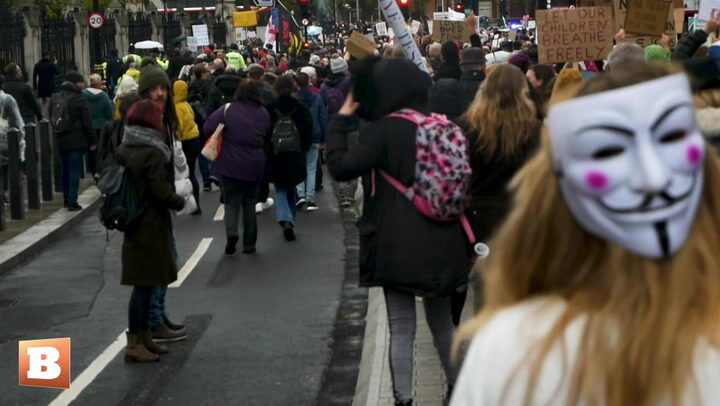How Ernst Jünger predicted the ubiquity of masks
10 September, 2020
Huxley’s Brave New World (1932) has Alphas, Betas, and Epsilon Semi-Morons – genetically engineered classes with uniform clothing and uniform opinions. Orwell’s Nineteen Eighty-Four (1948) has the Thought Police and Newspeak. While Zamyatin’s We (1921) has numbers instead of people – D-503, I-330, O-90: vowels for females, consonants for males.
If there is a single defining characteristic of dystopian literature, it is the eradication of all individuality. “Self-consciousness”, Zamyatin writes, “is just a disease”. For this reason, dystopias are invariably told by tormented outsiders: those who are well aware of the commodity-like standardisation of their fellow humans, yet either fear the consequences of speaking out or resent their own sense of self. After all, “no offence is so heinous as unorthodoxy of behaviour”, as Huxley writes.
Given their tyrannical preoccupation with uniformity, it is little wonder that, as a literary form, dystopias emerged at the beginning of the twentieth century. The totalitarian regimes of Russia and Germany as well as their technocratic Western counterparts, inspired by the likes of F. W. Taylor and Henry Ford, were central sources of inspiration. For all their apparent differences, these competing ideologies are united by the utopian attempt to redraw not just society, but the human being himself. The increasing power of science and technology gave rise to the idea that nature itself, in all its messy complexity, could be finally put straight.
Besides these three canonical authors, however, this generation produced another equally impressive, if much less well known, dystopian writer: the enigmatic German, Ernst Jünger. Known primarily for his First World War diaries and steadfast opposition to Weimar liberalism, Jünger went on to live until the age of 103, writing on topics from entomology and psychedelics to nihilism and photography. In the second half of his career he produced three principal works of dystopian fiction: Heliopolis (1949), Eumeswil (1977), and, perhaps his finest, The Glass Bees (1957).
Arguably his most chilling vision, however, is offered in an extended essay published on the eve of the Nazi ascension to power in 1932. The Worker, as Jünger calls it, aims to sketch what he regards as the coming new world order – an order defined by a fundamentally new type of human. Having dispensed with the liberal values of the past and embraced his fate in the factories and on the battlefields of the early twentieth century, the hallmark of the new man is an uncanny resemblance – both in body and soul – to the machine. Born to human parents, Jünger’s “worker” is nevertheless a child of the industrial age.
Following the dystopias of his contemporaries, the prime casualty of this new age is also the individual. For the logic of the machine permits no difference. Whether the natural world or the human mind, Jünger argues that everything is increasingly defined by “a certain emptiness and uniformity”. The result, to use Orwell’s words, is “a nation of warriors and fanatics, marching forward in perfect unity, all thinking the same thoughts and shouting the same slogans” – millions of people, he adds, “all with the same face”.
Our readiness to hide our face reflects the dehumanising tendencies that underlie the modern period.-
It is in this last respect that The Worker takes on a disturbing relevance for our own times. For the uniformity of the new age is symbolised, Jünger suggests, by the sudden proliferation of the mask in contemporary society. “It is no coincidence”, he writes, “that the mask is again beginning to play a decisive role in public life. It is appearing in many different ways … be it as a gas mask, with which they are trying to equip entire populations; be it as a face mask for sport and high speeds, seen on every racing driver; be it as a safety mask for workplaces exposed to radiation, explosions, or narcotic substances. We can assume”, he continues, with an eerie prescience, “that the mask will come to take on functions that we can today hardly imagine”.
Given the sudden ubiquity of the face mask in 2020, across the entire globe and in an increasing number of social contexts, it is impossible to avoid the conclusion that this is precisely the sort of development Jünger had in mind. Our readiness to obscure the face reflects the dehumanising tendencies that, for Jünger, underlie the modern period. It represents another stage in the degradation of the individual that became explicit in the First World War. Whether as a scrap of material on the battlefield or a cog in the machine of the wartime economy, the modern age has a habit of reducing the human being to a functional object. Everything “non-essential” – everything, that is, that makes us human – is blithely discarded.
The question for us is what it means to resemble such a dystopian vision. Are we happy to rationalise the transformations of our everyday lives, or are we concerned by the proximity of today’s world with some of the most basic dystopian tropes? Whether the call for social isolation, perpetual “vigilance”, or mandatory face masks, the measures of the last six months represent more than an assault on liberty. They implicitly enjoin us to sacrifice our humanity in order to save our lives. Even if this Rubicon has not yet been crossed, it is worth thinking about the point at which it is. For perhaps there is more to life than its mere continuation. Perhaps “the object”, as Winston Smith well knew, “is not to stay alive but to stay human”.





